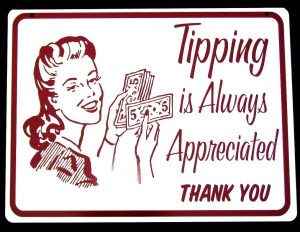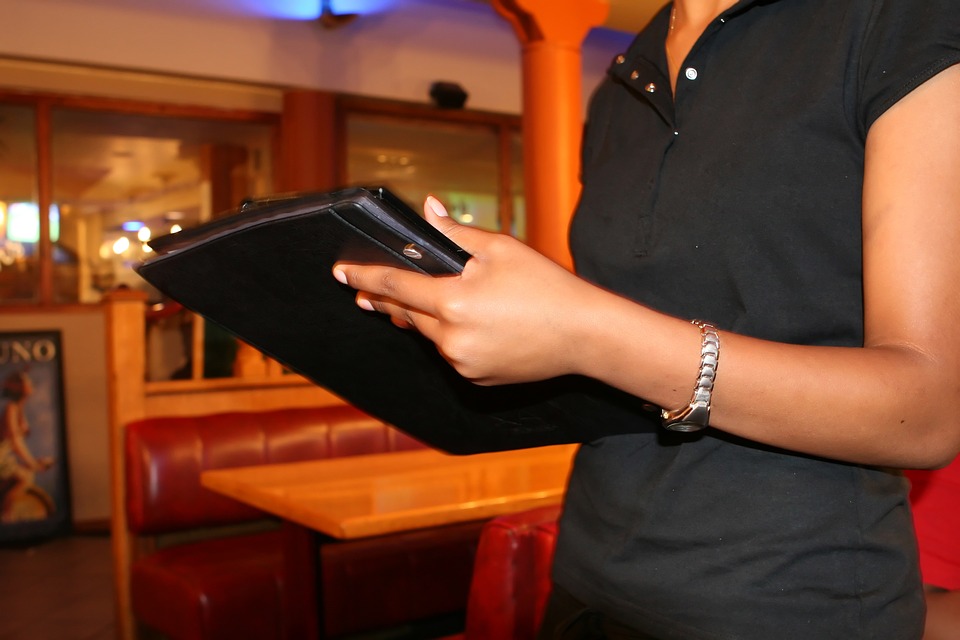After the Civil War, traveling wealthy Americans showed off their worldly knowledge by bringing the European custom of tipping back to the U.S.
Eventually, tipping became firmly embedded in the American culture. As Jarod Kintz put it, “A thank you and a warm smile are always made warmer by a transfer of money.”
Food servers have techniques to increase tips. They’ve learned to kneel so they’re eye-level with diners, to touch diners on the shoulder, to write thank you notes and smiley-faces on the bill, and to hand out candy when delivering the check; all tricks to increase their take.
That’s because food servers often depend on tips to make ends meet.

Many diners are unaware that servers often earn a low hourly rate and then don’t get to keep all the gratuities they receive. After all, tips are taxable.
When a server earns $20 or more in cash or charged tips per calendar month, they must report the total to the IRS and pay federal income, Social Security and Medicare taxes on them.
Some restaurants pay employees their cash and credit card tips at the end of their shifts tax free, but employees must still provide a tip report to detail the amount of tips they made per pay period. This ensures that all tips are reported and taxes paid.
Employers are required to provide ways for employees to record tips, but they cannot control whether or not an employee correctly reports them.
Charged tips are usually documented on a POS system via customers’ receipts but cash tips are harder to keep track of.
The IRS knows this.
Consequently, the IRS expects to see tips reported at 8% or higher of gross food and beverage receipts, excluding carry out sales and sales with an imposed service charge of at least 10%.
When tips are reported below 8% of gross sales, it’s is a red flag that employees may be under-reporting tips and may result in a costly, inconvenient audit.
Should an establishment’s total tips be reported below 8%, then they must raise the total tips to above 8% by allocating additional tip income to the W2s of employees who failed to report more than 8% of their sales.
Employers look at things like total hours worked, share of gross receipts, and good faith agreements when deciding which employees should have allocated tips.
The amount allocated should be entered In the ‘allocated tips’ box 8 on Form W2, Wage and Tax Statement. The allocated tips amount from Form W2 must then be reported on a Form 4137, Social Security and Medicare Tax on Underreported Tip Income.
Unless the employee can establish that they received an amount less than the allocated tips stated, this form 4137 must be attached and filed with Form 1040. Since the employee did not actually report these allocated amounts to the employer, no federal income, social security or Medicare taxes should be withheld from allocated tips.
In an effort to enhance tax compliance, the IRS recently began offering tip agreements to employers, such as TRAC (Tip Reporting Alternative Commitment) and EmTRAC (Employer-designed Tip Reporting Alternative Commitment), to encourage employees to report tips correctly through education instead of tip examinations and other enforcement actions.
If your establishment has more than 10 employees who worked more than 80 hours on a typical business day during the preceding calendar year, and if tipping is a customary practice and food or beverage is consumed on your premises, then you are a large food or beverage establishment according to the IRS.
Employers who operate large food or beverage establishments are required to report all employee tip income at the end of the year by filing Form 8027 (Employer’s Annual Information Return of Tip Income and Allocated Tips). Form 8027 is due on the last day of February of the next year, or March 31st if filing online.
For restaurants and other businesses that employ tip-earning staff, it’s imperative that employers ensure their employees accurately report tips.
The bookkeepers at Sherman Oaks Accounting & Bookkeeping powered by One Source Services, Inc. are tip-reporting experts.
Our preferred method of tracking tips and taxes is through Quickbooks Online Payroll where tips can be managed and taxes conveniently paid with payroll deductions.
For employers who pay-out cash tips at shift-end but include charged tips on paychecks, cash tips can be entered in QBO and charged tips can be entered separately so that employees receive charged tips on their paychecks and still have taxes conveniently deducted.
It all comes down to employers making sure they receive accurate tip reports from employees and that tips are reported as at least 8% of gross food and beverage sales to avoid raising suspicions of under-reporting.
If under-reporting does occur, then employers must allocate tips to the offending employees’ W2s.
Additionally, employers may sign a tip agreement with the IRS to reduce penalties for under-reporting by ensuring that employees are properly educated on how to report tips.
The bookkeepers at Sherman Oaks Accounting & Bookkeeping powered by One Source Services, Inc. can audit your tips reporting and taxes before you ping the IRS’ radar.
Let us identify areas of opportunity and collaborate to implement better processes.
We aim to simplify finances and help our clients live their best entrepreneurial life.

